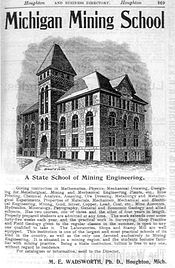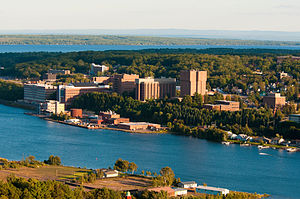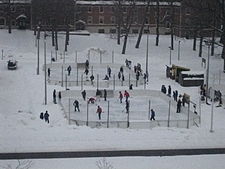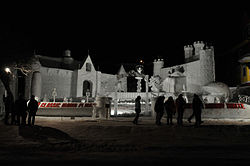- Michigan Technological University
-
Michigan Technological University 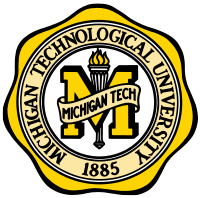
Motto Create the Future Established 1885 Type Public Endowment US$63.6 million[1] President Glenn D. Mroz Academic staff 458[2] Admin. staff 1,269[2] Students 6,957[3] Undergraduates 5,639[3] Postgraduates 1,318[3] Location Houghton, Michigan, USA
47°07′N 88°33′W / 47.12°N 88.55°WCoordinates: 47°07′N 88°33′W / 47.12°N 88.55°WCampus 925 acres (3.74 km2), Rural Colors School: metallic gold and silver[4]
Athletics: gold and blackAthletics NCAA Division I, men's hockey
NCAA Division II, 13 varsity teamsNickname Huskies Mascot Blizzard T. Husky Website mtu.edu 
Michigan Technological University (commonly referred to as Michigan Tech, MTU, or simply Tech) is a public research university located in Houghton, Michigan, United States. Its main campus sits on 925 acres (374 ha) on a bluff overlooking Portage Lake. Michigan Tech was founded in 1885 as the first post-secondary institution in the Upper Peninsula of Michigan, and was created to train mining engineers to operate the local copper mines.
The university's name has changed three times to reflect expansions of degree offerings. Science, technology, forestry and business have been added to the numerous engineering disciplines, and Michigan Tech now offers more than 130 degree programs though its five colleges and schools. US News and World Report ranked Michigan Tech's undergraduate program 115th in the nation based on peer assessment, student selectivity, financial resources and other factors.[5] Michigan Tech was also rated among the "Best in the Midwest" by The Princeton Review.[6]
Michigan Tech's athletic teams are nicknamed the Huskies and compete primarily in the NCAA Division II Great Lakes Intercollegiate Athletic Conference (GLIAC). The men's hockey team competes in Division I as a member of the Western Collegiate Hockey Association (WCHA), and has won three national championships.
Contents
History
Michigan Tech was founded in 1885 as the Michigan Mining School.[7] Established by the state of Michigan to train mining engineers to operate the local copper mines, the school started with four faculty members and twenty-three students. A few years after the school's creation, enrollment grew to such a point that its name no longer reflected its purpose. The name was then changed to the Michigan College of Mines. This name lasted through World War I until 1925, but by this time the school had begun offering a wider variety of degrees and once again decided to change its name to the Michigan College of Mining and Technology. By 1931 enrollment had reached nearly 600. During the next few years, due to the Great Depression, money was scarce, causing department heads and even the president of the university, William Hotchkiss, to take pay cuts. Grover C. Dillman was president from 1935 to 1956. During this time, the school underwent many notable changes: a few of these include the construction of the Memorial Union Building and purchase of an ice rink and golf course. Around 1948, enrollment passed 2000 students total. In 1956, J. Robert Van Pelt became the new president of the university. He restarted many PhD programs and created a focus on research. This included the schools first analog computation class in 1956-1957.[8] In the final years of his presidency, the school changed from a college to a university, changing its name a final time to Michigan Technological University. The change from the Michigan College of Mining and Technology was necessary for two reasons, according to Van Pelt. First, the college had expanded too greatly and the current name was no longer an accurate title. Also, including "mining" in the name of the college was misleading.[9] The name Michigan Technological University was chosen in order to retain the nickname of Michigan Tech that had already been in use since 1927. Although engineering still accounts for some 59 percent of all enrollment as of fall 2010, the University now offers more than 130 degree programs. Along with the new name, Michigan Technological University, the school gained new constitutional status in 1964. The new status gave responsibility for control of the university to its Board of Control rather than legislature.[10]
Campus
Main article: Campus of Michigan Technological UniversityThe main Michigan Tech campus is located mainly on US 41 in Houghton, Michigan. It is the safest campus in Michigan, and the third safest in the United States according to Reader's Digest.[11] The main part of campus is relatively small, and can be traversed in about 10 minutes. Many of the buildings are built up, as opposed to short and wide, which reduces the size of the campus.In addition, the offices of the Michigan Tech Fund are located in the Citizens Bank Building in Hancock.[12]
Faculty are involved in several distance education programs with clients such as General Motors.
The Portage Lake Golf Course opened for play in April 1902. In 1945 the members could no longer support the needs of the course and sold it to Michigan Tech for one dollar. Since then many improvements have been made such as the addition of another nine holes in 1969. Then in 1984 the new clubhouse was constructed. In 1996 a sprinkler system was installed to modernize the course and keep it playable. The Portage Lake Golf Course is located two miles (3 km) southeast of campus.
Academics
University rankings (overall) National Forbes[13] 492 U.S. News & World Report[14] 115 Washington Monthly[15] 165 Michigan Tech is known for academic excellence in engineering, natural and physical sciences, computing, business and economics, technology, environmental studies, arts, humanities, and social sciences.[who?] The university is divided into five schools and colleges. The average overall ACT scores for incoming students is 26.4 in fall 2010,[16] compared to 21.2 nationally. The College of Engineering's environmental engineering, geological engineering, and mechanical engineering enrollments all rank in the top ten nationally.[17] The electrical engineering department uses an innovative "DSP First" curriculum found at only a few leading universities.[18] The cornerstone of this program is an introductory course in digital signal processing (DSP).
- The College of Engineering. Its departments are biomedical engineering, civil engineering, mechanical engineering-engineering mechanics, electrical and computer engineering, chemical engineering, materials science and engineering, and geological and mining engineering and sciences.[3]
- The College of Sciences and Arts has majors in many diverse fields including: physics, mathematics, kinesiology and interpretive physiology, social sciences, biological sciences, bio-informatics, and computer science.[3] It includes one of the largest technical communications programs in the United States. The College is also home to education, psychology, theater, and Air Force and Army ROTC programs.
- The School of Business and Economics is accredited by AACSB, the premier accrediting body for business schools. Students can receive a bachelor of science degree in seven areas, including accounting, economics, finance, management, management information systems, marketing, and operations and systems management. The undergraduate program includes a unique Business Development Experience, where students gain real-life business experience in a mentored environment. Students also have the opportunity to join several business student organizations, including the Applied Portfolio Management Program where they invest $1 million in the stock market each year.
- The School of Forest Resources and Environmental Science has been recognized nationally for excellence in its research program, and its PhD program was ranked fourth in the nation by Academic Analytics in 2007.[19] The School maintains greenhouses, labs, and the 4,000-acre (16 km2) Ford Forest and Ford Center in nearby Alberta, and celebrates its 75th year in 2011.
- The School of Technology features the BS in Computer Networks and System Administration, Electrical Engineering Technology, Mechanical Engineering Technology, Surveying Engineering, Construction Management, and Industrial Technology.
Michigan Tech has also developed an alternative program to provide students with engineering and other design experience called the Enterprise program. Enterprises develop engineering skills by allowing students to work in business-like environments on real-world projects while completing their education. Enterprises include Nanotechnology Innovations, Hybrid Transportation, Aerospace, Blue Marble Security, Husky Game Development, Boardsports Technologies, Integrated Microsystems, and Wireless Communications Enterprises.[20]
Student body
The student body consists of nearly 7,000 graduate and undergraduate students (Fall 2010)[3] and more than 450 academic faculty (Fall 2010).[2] As is historically true of engineering institutions, female enrollment at Michigan Tech is low. The male to female student ratio was 22:1 in 1960; since 1980 it has remained around 3:1. Michigan Tech's admissions office has enlisted female students and faculty to contact every admitted female applicant via telephone or personal letter in an attempt to increase female enrollment.[21] The Fall 2010 freshman class had a ratio of 3.1:1.[3]
Michigan Tech students are primarily from Michigan, Wisconsin, Minnesota, and Illinois. The student body is approximately 75.4% White/Non-Hispanic, 14.2% International, 1.6% Hispanic, 1.5% percent African American, 1.0% Asian, 0.6% Native American, 1.0% Multiracial, 0.1% Pacific Islander, and the remaining 4.5% was not supplied.[3] The university has recently focused on achieving a more diverse student body, in terms of ethnicity, gender, and areas of study. A key step in this effort was the recent introduction of several new academic majors, including psychology, biochemistry and molecular biology, Cheminformatics, communication and culture studies, pharmaceutical chemistry, exercise science, sound design, audio production, and theater and entertainment technology.
Research
Michigan Tech ranked 172nd of 600 US colleges and universities in research and development expenditures in 2007.[22] Michigan Tech ranks ahead of Michigan State, the University of Michigan, Wayne State, and benchmark universities RPI, Georgia Tech, Carnegie Mellon, and Notre Dame in invention disclosures per $10 million of research.[citation needed] Research expenditures exceeded $50 million in 2009.[23]
Student life
Students attending Michigan Technological University have a wide range of activities to participate in, whether or not they are living in the residence halls. In addition to the various small interest groups which form throughout the year, they participate in Greek Life, Student Organizations, and the Enterprise Program; many organize and attend varsity day events, such as K-Day, the Parade of Nations, and the Winter Carnival (which also attracts alumni from across the country); furthermore, there are motivational drives to raise student activity levels and involvement in the school community, typically for those without membership in a student organization.
Student organizations
Michigan Tech currently recognizes more than two hundred student organizations,[24] including:
- Alpha Phi Omega, Epsilon Lambda chapter, National Co-ed Service Fraternity
- Blue Key, an affiliate of the National Blue Key honor society, which organizes the annual Winter Carnival
- The Huskies Pep Band, an integral part to football, men's and women's basketball, and ice hockey
- The Michigan Tech Lode, an award-winning, weekly student newspaper
- Undergraduate Student Government[25]
- WMTU-FM, a student-run radio station
Greek life
Michigan Tech is currently host to seventeen fraternities, including three international fraternities and three local fraternities.[26] Additionally, there are eight sororities on campus, including four local sororities.[27]
Athletics
Main article: Michigan Tech HuskiesAs the school mascot is the husky (specifically, Blizzard T. Husky), the school's sports teams are known as the "Huskies". Michigan Tech competes in the NCAA's Division II Great Lakes Intercollegiate Athletic Conference. The men's hockey team competes in Division I as a member of the Western Collegiate Hockey Association. Michigan Tech owns a downhill ski/snowboard hill, Mont Ripley, just across Portage Lake from campus, and maintains extensive cross-country ski trails (used for mountain biking in summer).
School songs
Michigan Tech has both an official fight song and an official Alma Mater. At most sporting events, however, both the "Engineer's Song" and "In Heaven There Is No Beer" are played by the Huskies Pep Band, and many students consider these to be the unofficial school songs. The "Blue Skirt Waltz" is played at home ice hockey games and is called the "Copper Country Anthem." During the song, the fans join arms and swing back and forth to the music.
Special events
- The first Friday of the fall term is K-Day (Keweenaw Day), a university-sponsored, half-day holiday hosted by Greek Life. It is primarily celebrated at nearby McLain State Park. Activities include a student organizations fair, games, swimming, and music.
- Michigan Tech has celebrated Homecoming since 1929.
- Each fall Michigan Tech hosts Parade of Nations.
- Winter Carnival is where students compete in a variety of artistic and athletic events. The highlight of Winter Carnival is a snow statue competition in which students construct snow and ice sculptures consistent with an annual theme.
- In spring, Michigan Tech hosts Spring Fling, which celebrates the coming end of the school year. Local talent plays on stage, carnival games are offered, free food can be found, and the entire campus is transformed into a festival.
- In the summer Michigan Tech hosts the Summer Youth Program (SYP), Women in Engineering (WIE), Engineering Scholars Program (ESP), and National Summer Transportation Institute (NSTI) to introduce high school students to college opportunities.
- During June and July, Michigan Tech's Rozsa Center for the Performing Arts is one of the main venues for the Pine Mountain Music Festival
- Michigan Tech holds two world records, the largest snowball (21' 3" circumference) and largest snowball fight (3,745), which they accomplished in 2006, as verified by Guinness World Records officials. They originally held three world records, the third of which was the most people making snow angels simultaneously in a single venue (3,784). This record was taken from the city of Bismarck, ND, but about a year later, Bismarck took the record back with 8,962 snow angels.[28]
People
There are over 68,000 Michigan Tech alumni living in all 50 states and over 100 countries. Some notable alumni include:
- Joe Berger, NFL player
- Melvin Calvin, Nobel Laureate and discoverer of the Calvin Cycle
- Chris Conner, NHL player
- David Edwards, biomedical engineering professor at Harvard, writer[29]
- Tony Esposito, former NHL player
- David House, former vice president of Intel
- Randy McKay, former NHL player
- Davis Payne, head coach of the St. Louis Blues
- Kanwal Rekhi, businessman and entrepreneurship promoter in the Silicon Valley[30]
- Richard J. Robbins, whose company built five of the six machines used to dig the Chunnel between Great Britain and France.[31] He received a 2009 Benjamin Franklin Medal for his tunneling innovations.[32]
- Damian Rhodes, former NHL player
- Donald G. Saari, prominent game theorist
- Alexander King Sample, 12th Bishop of the Roman Catholic Diocese of Marquette[33]
- John Scott, NHL player
- Donald Shell, author of the Shell sort
- Matthew Songer, founder and chief executive officer of Pioneer Surgical Technology[34]
- Andy Sutton, NHL player
- John Vartan, businessman, developer, banker, restaurateur and philanthropist
See also
References
- ^ As of June 30, 2009. "U.S. and Canadian Institutions Listed by Fiscal Year 2009 Endowment Market Value and Percentage Change in Endowment Market Value from FY 2008 to FY 2009" (PDF). 2009 NACUBO-Commonfund Study of Endowments. National Association of College and University Business Officers. http://www.nacubo.org/Documents/research/2009_NCSE_Public_Tables_Endowment_Market_Values.pdf. Retrieved February 26, 2010.
- ^ a b c "Total Employee Profile – Fall 2010". http://www.admin.mtu.edu/ia/faculty/totemp10.html. Retrieved June 9, 2011.
- ^ a b c d e f g h "Enrollment Statistics". http://www.admin.mtu.edu/em/services/erlstat/. Retrieved June 9, 2011.
- ^ "Nontraditional Students at Michigan Technological University". Michigan Technological University. Archived from the original on 2008-05-01. http://web.archive.org/web/20080501081720/http://www.edopp.mtu.edu/nontraditional/traditions.htm. Retrieved 2008-04-23.
- ^ "Best Colleges 2012 - Michigan Technological University". http://colleges.usnews.rankingsandreviews.com/best-colleges/michigan-technological-university-2292. Retrieved September 14, 2011.
- ^ "Princeton Review’s "The Best 373 Colleges, 2011 Edition" - Michigan Technological University". http://www.princetonreview.com/MichiganTechnologicalUniversity.aspx. Retrieved July 20, 2011.
- ^ "Michigan Technological University History". http://www.mtu.edu/mtuinfo/history.html. Retrieved 2008-01-07.
- ^ Waltman, Gene L.. "Black Magic and Gremlins: Analog Flight Simulations at NASA's Flight Research Center". NASA SP-2000-4520. NASA Technical Reports Server. http://hdl.handle.net/2060/20010011952. Retrieved 13 September 2011.
- ^ "Michigan Technological University: A History". http://www.sas.it.mtu.edu/urel/welcome/history.html. Retrieved 2010-03-30..
- ^ "Why a New Name and Constitutional Status for Michigan College of Mining and Technology" Vertical File: History- MTU-Name Change from MCMT to MTU. Michigan Tech Archives & Copper Country Historical Collections.
- ^ "Ranking of the Safest (and Least Secured) campuses". http://www.rd.com/family/ranking-the-safest-and-worst-college-campuses/. Retrieved June 23, 2011.
- ^ http://www.admin.mtu.edu/rbb.html
- ^ "America's Best Colleges". Forbes. 2011. http://www.forbes.com/top-colleges/list/. Retrieved October 6, 2011.
- ^ "National Universities Rankings". America's Best Colleges 2012. U.S. News & World Report. September 13, 2011. http://colleges.usnews.rankingsandreviews.com/best-colleges. Retrieved September 25, 2011.
- ^ "The Washington Monthly National University Rankings". The Washington Monthly. 2011. http://www.washingtonmonthly.com/college_guide/rankings_2011/national_university_rank.php. Retrieved August 30, 2011.
- ^ "Michigan Tech Dashboard". http://www.admin.mtu.edu/urel/dashboard/. Retrieved June 23, 2011.
- ^ http://www.doe.mtu.edu/
- ^ http://www.ece.mtu.edu/pages/academics/BSEE.html/
- ^ "Academic Analytics". http://www.academicanalytics.com/.
- ^ http://www.enterprise.mtu.edu
- ^ Goodrich, Marcia (Fall 2009). "Where the Boys Are". Michigan Tech Magazine (Houghton, MI: Michigan Technological University) 46 (2). Archived from the original on July 21, 2011. http://www.webcitation.org/60LQeQqHh. Retrieved July 21, 2011.
- ^ "Center for Measuring University Performance". http://mup.asu.edu/research2009.pdf.
- ^ "Michigan Tech Research Funding Climbs". December 1, 2009. http://www.mtu.edu/news/stories/2009/december/story20412.html.
- ^ http://www.sa.mtu.edu/stulife/stuorg/
- ^ https://www.banweb.mtu.edu/pls/owa/stuorg.STU_ORG_DATA.p_list?orderby=cat
- ^ http://www.sa.mtu.edu/greek/fraternity.html
- ^ http://www.sa.mtu.edu/greek/sorority.html
- ^ [1] accessed on July 29, 2007.
- ^ "Alumni Relations – Dr. David Edwards". Alumni Relations. Michigan Technological University. Archived from the original on July 21, 2011. http://www.webcitation.org/60LRwUwPl. Retrieved July 21, 2011.
- ^ "Alumni Relations – Dr. Kanwal Rekhi". Alumni Relations. Michigan Technological University. Archived from the original on July 21, 2011. http://www.webcitation.org/60LSAWos3. Retrieved July 21, 2011.
- ^ "Dr. Richard J. Robbins '56 Inducted into the Academy 1998". Michigan Technological University. http://www.geo.mtu.edu/academy/photos/Mining/Robbins.html. Retrieved 2010-07-12.
- ^ "2009 Franklin Institute Awards - Richard J. Robbins". Franklin Institute. http://www.fi.edu/franklinawards/09/bf_engineer.html. Retrieved 2010-07-12.
- ^ "Alumni Relations – Rev. Alexander Sample". Alumni Relations. Michigan Technological University. Archived from the original on July 21, 2011. http://www.webcitation.org/60LS32ncd. Retrieved July 21, 2011.
- ^ "Alumni Relations – Dr. Matthew Songer M.D.". Alumni Relations. Michigan Technological University. Archived from the original on July 21, 2011. http://www.webcitation.org/60LSKDGXp. Retrieved July 21, 2011.
External links
Michigan Technological University Campus Athletics Student groups Other Great Lakes Intercollegiate Athletic Conference Current members Ashland • Ferris State • Findlay • Grand Valley State • Hillsdale • Lake Erie • Lake Superior State • Michigan Tech • Northern Michigan • Northwood • Ohio Dominican • Saginaw Valley State • Tiffin • Wayne State
Associate members Former members Gannon • Mercyhurst • Oakland • Westminster
Colleges and universities in Michigan Public institutions Central Michigan · Eastern Michigan · Ferris State · Grand Valley State · Lake Superior State · Michigan State · Michigan Tech · Northern Michigan · Oakland · Saginaw Valley State · UM–Ann Arbor · UM–Dearborn · UM–Flint · Wayne State · Western Michigan
Private institutions Adrian · Albion · Alma · Andrews · Aquinas · Calvin · Cleary · College for Creative Studies · Concordia · Cornerstone · Davenport · Detroit Mercy · Finlandia · Grace Bible · Hillsdale · Hope · Kalamazoo · Kettering · Kuyper · Lawrence Tech · Madonna · Marygrove · Northwood · Olivet · Rochester · Saint Mary's · Siena Heights · Spring Arbor · Walsh · William Tyndale
Community colleges Alpena CC · Bay de Noc CC · Bay Mills CC · Delta · Glen Oaks CC · Gogebic CC · Grand Rapids CC · Henry Ford CC · Jackson CC · Kalamazoo Valley CC · Kellogg CC · Kirtland CC · Lake Michigan · Lansing CC · Macomb CC · Mid Michigan CC · Monroe County CC · Montcalm CC · Mott CC · Muskegon CC · North Central Michigan · Northwestern Michigan · Oakland CC · St. Clair County CC · Schoolcraft · Southwestern Michigan · Washtenaw CC · Wayne County CC · West Shore CC
Colleges and universities in Michigan's Upper Peninsula Finlandia University • Lake Superior State University • Michigan Tech • Northern Michigan UniversityBay de Noc Community College • Bay Mills Community College • Gogebic Community CollegeCategories:- Michigan Technological University
- Educational institutions established in 1885
- North Central Association of Colleges and Schools
- Schools of mines
- Universities and colleges in Michigan
- Education in Houghton County, Michigan
- Technical universities and colleges
- Oak Ridge Associated Universities
- Association of Public and Land-Grant Universities
- American Association of State Colleges and Universities
- Forestry education
- Buildings and structures in Houghton County, Michigan
Wikimedia Foundation. 2010.

